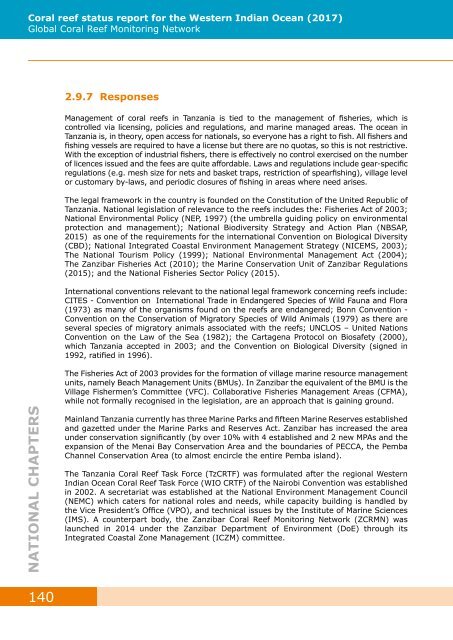GCRMN_COI_2017-Western Indian Ocean Reef Status
GCRMN Western Indian Ocean Coral Reef Status report for 2017. Produced by the Indian Ocean Commission and CORDIO East Africa
GCRMN Western Indian Ocean Coral Reef Status report for 2017. Produced by the Indian Ocean Commission and CORDIO East Africa
You also want an ePaper? Increase the reach of your titles
YUMPU automatically turns print PDFs into web optimized ePapers that Google loves.
Coral reef status report for the <strong>Western</strong> <strong>Indian</strong> <strong>Ocean</strong> (<strong>2017</strong>)<br />
Global Coral <strong>Reef</strong> Monitoring Network<br />
2.9.7 Responses<br />
Management of coral reefs in Tanzania is tied to the management of fisheries, which is<br />
controlled via licensing, policies and regulations, and marine managed areas. The ocean in<br />
Tanzania is, in theory, open access for nationals, so everyone has a right to fish. All fishers and<br />
fishing vessels are required to have a license but there are no quotas, so this is not restrictive.<br />
With the exception of industrial fishers, there is effectively no control exercised on the number<br />
of licences issued and the fees are quite affordable. Laws and regulations include gear-specific<br />
regulations (e.g. mesh size for nets and basket traps, restriction of spearfishing), village level<br />
or customary by-laws, and periodic closures of fishing in areas where need arises.<br />
The legal framework in the country is founded on the Constitution of the United Republic of<br />
Tanzania. National legislation of relevance to the reefs includes the: Fisheries Act of 2003;<br />
National Environmental Policy (NEP, 1997) (the umbrella guiding policy on environmental<br />
protection and management); National Biodiversity Strategy and Action Plan (NBSAP,<br />
2015) as one of the requirements for the international Convention on Biological Diversity<br />
(CBD); National Integrated Coastal Environment Management Strategy (NICEMS, 2003);<br />
The National Tourism Policy (1999); National Environmental Management Act (2004);<br />
The Zanzibar Fisheries Act (2010); the Marine Conservation Unit of Zanzibar Regulations<br />
(2015); and the National Fisheries Sector Policy (2015).<br />
International conventions relevant to the national legal framework concerning reefs include:<br />
CITES - Convention on International Trade in Endangered Species of Wild Fauna and Flora<br />
(1973) as many of the organisms found on the reefs are endangered; Bonn Convention -<br />
Convention on the Conservation of Migratory Species of Wild Animals (1979) as there are<br />
several species of migratory animals associated with the reefs; UNCLOS – United Nations<br />
Convention on the Law of the Sea (1982); the Cartagena Protocol on Biosafety (2000),<br />
which Tanzania accepted in 2003; and the Convention on Biological Diversity (signed in<br />
1992, ratified in 1996).<br />
NATIONAL CHAPTERS<br />
The Fisheries Act of 2003 provides for the formation of village marine resource management<br />
units, namely Beach Management Units (BMUs). In Zanzibar the equivalent of the BMU is the<br />
Village Fishermen’s Committee (VFC). Collaborative Fisheries Management Areas (CFMA),<br />
while not formally recognised in the legislation, are an approach that is gaining ground.<br />
Mainland Tanzania currently has three Marine Parks and fifteen Marine Reserves established<br />
and gazetted under the Marine Parks and Reserves Act. Zanzibar has increased the area<br />
under conservation significantly (by over 10% with 4 established and 2 new MPAs and the<br />
expansion of the Menai Bay Conservation Area and the boundaries of PECCA, the Pemba<br />
Channel Conservation Area (to almost encircle the entire Pemba island).<br />
The Tanzania Coral <strong>Reef</strong> Task Force (TzCRTF) was formulated after the regional <strong>Western</strong><br />
<strong>Indian</strong> <strong>Ocean</strong> Coral <strong>Reef</strong> Task Force (WIO CRTF) of the Nairobi Convention was established<br />
in 2002. A secretariat was established at the National Environment Management Council<br />
(NEMC) which caters for national roles and needs, while capacity building is handled by<br />
the Vice President’s Office (VPO), and technical issues by the Institute of Marine Sciences<br />
(IMS). A counterpart body, the Zanzibar Coral <strong>Reef</strong> Monitoring Network (ZCRMN) was<br />
launched in 2014 under the Zanzibar Department of Environment (DoE) through its<br />
Integrated Coastal Zone Management (ICZM) committee.<br />
140


















